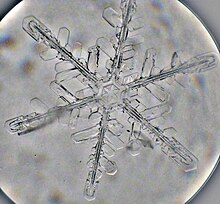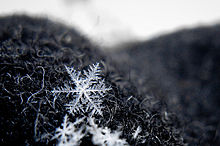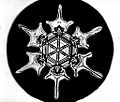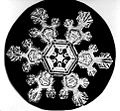Snowflake

Snowflakes are conglomerations of frozen ice crystals which fall through the Earth's atmosphere. They begin as snow crystals which develop when microscopic supercooled cloud droplets freeze. Snowflakes come in a variety of sizes and shapes. Complex shapes emerge as the flake moves through differing temperature and humidity regimes, such that individual snowflakes are nearly unique in structure. Snowflakes encapsulated in rime form balls known as graupel. Snowflakes appear white in color despite being made of clear ice. This is due to diffuse reflection of the whole spectrum of light by the small crystal facets.[1]
Formation

Snow crystals form when tiny supercooled cloud droplets (about 10 μm in diameter) freeze. These droplets are able to remain liquid at temperatures lower than −18 °C (0 °F), because to freeze, a few molecules in the droplet need to get together by chance to form an arrangement similar to that in an ice lattice; then the droplet freezes around this "nucleus." Experiments show that this "homogeneous" nucleation of cloud droplets only occurs at temperatures lower than −35 °C (−31 °F).[2] In warmer clouds an aerosol particle or "ice nucleus" must be present in (or in contact with) the droplet to act as a nucleus. The particles that make ice nuclei are very rare compared to nuclei upon which liquid cloud droplets form, however it is not understood what makes them efficient. Clays, desert dust and biological particles may be effective,[3] although to what extent is unclear. Artificial nuclei include particles of silver iodide and dry ice, and these are used to stimulate precipitation in cloud seeding.[4]
Once a droplet has frozen, it grows in the supersaturated environment, which is one where air is saturated with respect to ice when the temperature is below the freezing point. The droplet then grows by deposition of water molecules in the air (vapor) onto the ice crystal surface where they are collected. Because water droplets are so much more numerous than the ice crystals due to their sheer abundance, the crystals are able to grow to hundreds of micrometers or millimeters in size at the expense of the water droplets. This process is known as the Wegner-Bergeron-Findeison process. The corresponding depletion of water vapor causes the droplets to evaporate, meaning that the ice crystals grow at the droplets' expense. These large crystals are an efficient source of precipitation, since they fall through the atmosphere due to their mass, and may collide and stick together in clusters, or aggregates. These aggregates are snowflakes, and are usually the type of ice particle that falls to the ground.[5] Guinness World Records list the world's largest snowflakes as those of January 1887 at Fort Keogh, Montana; allegedly one measured 38 cm (15 inches) wide.[6]
The exact details of the sticking mechanism remain controversial. Possibilities include mechanical interlocking, sintering, electrostatic attraction as well as the existence of a "sticky" liquid-like layer on the crystal surface. The individual ice crystals often have hexagonal symmetry. Although the ice is clear, scattering of light by the crystal facets and hollows/imperfections mean that the crystals often appear white in color due to diffuse reflection of the whole spectrum of light by the small ice particles.[7] The shape of the snowflake is determined broadly by the temperature and humidity at which it is formed.[5] Rarely, at a temperature of around −2 °C (28 °F), snowflakes can form in threefold symmetry — triangular snowflakes.[8] The most common snow particles are visibly irregular, although near-perfect snowflakes may be more common in pictures because they are more visually appealing. It is unlikely that any two snowflakes are alike due to the estimated 1019 (10 quintillion) water molecules which make up a typical snowflake,[9] which grow at different rates and in different patterns depending on the changing temperature and humidity within the atmosphere that the snowflake falls through on its way to the ground.[10] The METAR code for snow is SN, while snow showers are coded SHSN.[11]
Symmetry
A non-aggregated snowflake often exhibits six-fold radial symmetry. The initial symmetry can occur[12] because the crystalline structure of ice is six-fold. The six "arms" of the snowflake, or dendrites, then grow independently, and each side of each arm grows independently. Most snowflakes are not completely symmetric. The micro-environment in which the snowflake grows changes dynamically as the snowflake falls through the cloud, and tiny changes in temperature and humidity affect the way in which water molecules attach to the snowflake. Since the micro-environment (and its changes) are very nearly identical around the snowflake, each arm can grow in nearly the same way. However, being in the same micro-environment does not guarantee that each arm grows the same; indeed, for some crystal forms it does not because the underlying crystal growth mechanism also affects how fast each surface region of a crystal grows.[13]
Uniqueness

Snowflakes form in a wide variety of intricate shapes, leading to the popular expression that "no two are alike". Although statistically possible, it is very unlikely for any two snowflakes to appear exactly alike due to the many changes in temperature and humidity the crystal experiences during its fall to earth.[14][15][16][clarification needed] Initial attempts to find identical snowflakes by photographing thousands of them with a microscope from 1885 onward by Wilson Alwyn Bentley found the wide variety of snowflakes we know about today.[17] It is more likely that two snowflakes could become virtually identical if their environments were similar enough. Matching snow crystals were discovered in Wisconsin in 1988. The crystals were not flakes in the usual sense but rather hollow hexagonal prisms,[18] with identical complex snowflakes considered impossible.[19]
Use as a symbol

The snowflake is often a traditional seasonal image/motif used around the Christmas period, especially in Europe and the United States, representing the traditional White Christmas. During this period it is quite popular to make paper snowflakes by folding a piece of paper several times, cutting out a pattern with scissors and then unfolding it.[20][21]
Snowflakes are also often used as symbols representing winter or cold conditions. For example, snow tires which enhance traction during harsh winter driving conditions are labelled with a snowflake on the mountain symbol.[22] A snowflake was the symbol of the 2002 Winter Olympic Games in Salt Lake City, Utah.[23]
Three different snowflake symbols are encoded in Unicode: "snowflake" at U+2744 (❄); "tight trifoliate snowflake" at U+2745 (❅); and "heavy chevron snowflake" at U+2746 (❆).
Gallery
A selection of photographs taken by Wilson Bentley (1865–1931):
See also
- Timeline of snowflake research
- Koch snowflake, mathematical representation of snowflakes.
References
- ^ Jennifer E. Lawson (2001). Hands-on Science : Light, Physical Science (matter) - Chapter 5: The Colors of Light. Portage & Main Press. p. 39. ISBN 978-1-894110-63-1. Retrieved 2009-06-28.
- ^ Mason, Basil John. (1971). Physics of Clouds. Clarendon Press. ISBN 0-19-851603-7.
- ^ Christner, Brent Q. (2007). "Ubiquity of Biological Ice Nucleators in Snowfall". Science. 319 (5867): 1214. Bibcode:2008Sci...319.1214C. doi:10.1126/science.1149757. PMID 18309078.
{{cite journal}}: Unknown parameter|coauthors=ignored (|author=suggested) (help) - ^ Glossary of Meteorology (2009). "Cloud seeding". American Meteorological Society. Retrieved 2009-06-28.
- ^ a b M. Klesius (2007). "The Mystery of Snowflakes". National Geographic. 211 (1): 20. ISSN 0027-9358.
- ^ William J. Broad (2007-03-20). "Giant Snowflakes as Big as Frisbees? Could Be". New York Times. Retrieved 2009-07-12.
- ^ Jennifer E. Lawson (2001). Hands-on Science : Light, Physical Science (matter) – Chapter 5: The Colors of Light. Portage & Main Press. p. 39. ISBN 978-1-894110-63-1. Retrieved 2009-06-28.
- ^ Kenneth G. Libbrecht (2006-09-11). "Guide to Snowflakes". California Institute of Technology. Retrieved 2009-06-28.
- ^ John Roach (2007-02-13). ""No Two Snowflakes the Same" Likely True, Research Reveals". National Geographic News. Retrieved 2009-07-14.
- ^ Kenneth Libbrecht (Winter 2004/2005). "Snowflake Science" (PDF). American Educator. Retrieved 2010-10-19.
{{cite journal}}: Check date values in:|date=(help) - ^ Alaska Air Flight Service Station (2007-04-10). "SA-METAR". Federal Aviation Administration via the Internet Wayback Machine. Archived from the original on 2008-05-01. Retrieved 2009-08-29.
- ^ Nelson, Jon. "The Six-fold Nature of Snow".
- ^ Nelson, Jon. "Branch Growth and Sidebranching in Snow Crystals" (PDF).
- ^ Jon Nelson (2008-09-26). "Origin of diversity in falling snow" (PDF). Atmospheric Chemistry and Physics. Retrieved 2011-08-30.
- ^ John Roach (2007-02-13). ""No Two Snowflakes the Same" Likely True, Research Reveals". National Geographic News. Retrieved 2009-07-14.
- ^ Kenneth Libbrecht (Winter 2004/2005). "Snowflake Science" (PDF). American Educator. Retrieved 2009-07-14.
{{cite journal}}: Check date values in:|date=(help) - ^ Chris V. Thangham (2008-12-07). "No two snowflakes are alike". Digital Journal. Retrieved 2009-07-14.
- ^
Randolph E. Schmid (15 June 1988). "Identical snowflakes cause flurry". The Boston Globe. Associated Press. Retrieved 27 November 2008.
But there the two crystals were, side by side, on a glass slide exposed in a cloud on a research flight over Wausau, Wis.
- ^ Is it really true that no two snowflakes are alike?
- ^ for detailed instructions see for example this page
- ^ Other instructions and pictures of paper snowflakes
- ^ Tim Gilles (2004). Automotive chassis. Cengage Learning. p. 271. ISBN 978-1-4018-5630-4. Retrieved 2009-07-15.
- ^ International Olympic Committee (2009). "Olympic Games Salt Lake City 2002 - The emblem". Retrieved 2009-07-15.
Further reading
- Kenneth G. Libbrecht (2006). Ken Libbrecht's Field Guide to Snowflakes. Voyageur Press. ISBN 0-7603-2645-2.
External links
- Kenneth G. Libbrecht - Snowflake FAQ
- Ultra-high resolution images of snowflakes, hosted by the Electron Microscopy Unit of the USDA Beltsville Agricultural Research Center
- Snow Crystals and Snowflakes by Caltech
- Catch a Snowflake












